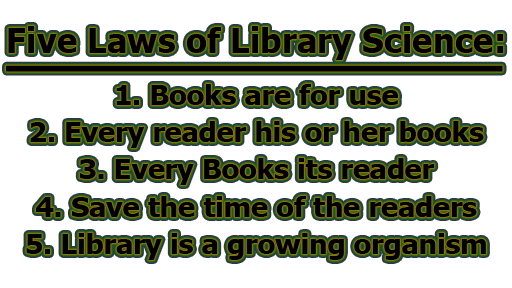Five Laws of Library Science:
The Five Laws of Library Science are a set of fundamental principles that were developed by S. R. Ranganathan, a librarian and educator from India, in the 1930s. They are still widely regarded as a foundational guide for library practice and management today. Here are the five laws:
1. Books are for use: In this case, the term ‘book’ should be interpreted broadly to stand document. Recognition of this law helps in removing restrictions on the use of books, i.e. making library service free from universal. The aim of the library is to ensure maximum use of reading materials. The first law is to be achieved through the following factors:
- Services, usages and accessibility: The greatness of a library is determined not only by the richness of its collection but by its services, usages and accessibility. A few books kept in constant and extensive use are more valuable than thousands of books kept in a palatial building. The Library schedule must be convenient for the reader. The large Library should open its door to the readers on holidays for some time.
- Publicity: The librarian should give fair publicity about the services offered by his/her library. He/ She should always publicize and add a new addition to the library so as to inform his/her clientele what new materials have been acquired. The latest arrival should be displayed.
- Building: The library building should be attractive. The exterior should be inviting and the interior should be well organized and decoration such a way that it could fascinate the readers or users. There should be proper lighting and ventilation, illustrations on the wall, coloured walls, a neat and clean environment, soundless room that encourages the readers to study or read more and more times.
- Equipment: The library pieces of equipment should be neat and attractive. The book racks should not so high. The reading room should be attractive and the chairs and tables should be suitable for continuous reading.
- Open access: Access to the library shelf should be unrestricted so that the readers can go to the shelves and pick out the book most suitable.
- The co-operation of library staff: Staff should be congenial towards the readers and should always be ready to help the readers.
2. Every reader of his or her books: The second law emphasizes in greater detail the implication of the first law as viewed from the side of readers. The service library should amplify the users’ demand and enhance the utility of book usage. The librarian should extend book usage through superfluous books. The second law is to achieve by the following factors:
- Book for all: The book should be for every type of reader irrespectively of age, sex, race, caste, religion, etc.
- Book selection: The second law not only emphasizes the selection of books for normal people but also for physically handicapped ones. Books have also to take care of the newly literate.
- Inter-Library loan: The entire book resources of a country can be made available through inter-library co-operation.
- Catalogue or analytical entries: A book of composite and complex nature should be explained fully to readers by catalogue or subject analytical entries.
- Open access: In open access books should be kept on open shelves so that the user could easily handle the book whenever he needs it.
3. Every Book has its reader: The third law ‘every book its reader’ points out that ultimately the book is meant for the reader and not for the filing stack room. It relates to finding out about every book in the library. Books cannot reach the hands of the readers on their own accord so it is the duty of the librarian to bring the readers into contact with the books. The third law is to be achieved by the following factors:
- Proper cataloguing: Proper cataloguing can also help in the use of books. A classified catalogue with analytical entries for all the hidden subjects in a book will go a long way in this direction.
- Book selection: Book selection should be for all users. Books which are not likely to be demanded by readers should not be selected for procurement.
- Publicity: The librarian should take care to draw the attention of the readers to those valuable books which lie unused and uncared for long period. Besides, he must give prompt publicity to new arrivals of books. This could be done by inserting a notification in the press or by periodical circulars, notices and displays, etc.
- Open access: Open access to Bookshelves can also help a lot in this respect.
4. Save the time of the readers: Books should be made available to the readers without delay. This is the law which really puts to test the efficiency of the library. The methods of classification, cataloguing, issuing of books, proper shelving of books etc, all play an important role in saving the time of the reader. This law is to be achieved by the following factors:
- Classification: Books should be classified as quickly as possible after accessioning so that the books go to the shelves without any time lag. Efforts should be made to make the book available to the readers within a week of its arrival.
- Cataloguing: This catalogue should be done systematically so that the readers can pick out what he wants. A classified catalogue will be found more useful than a dictionary catalogue, practically in special and academic libraries. But a dictionary catalogue is more useful in public libraries.
- Changing methods: The methods of issuing books and receiving them when returned should be such a way, that reader does not have to spend much time at the changing or discharging counter. Newark or Browne methods can be widely used in the library.
- Shelving: The book should be so arranged on the shelves that not only can they be found easily but the reader interested in a particular subject should be able to find them together.
- Open access: Open access saves not only the time of the reader but saves librarians also a lot of work.
5. Library is a growing organism: The library is an ever-expanding organization. The growth is of three kinds and they are as follows:
- Growth in size: Every library grows in size with the acquisition of new materials. A newly started library has to grow in size rapidly to serve its clientele. Unlimited growth creates many problems. The most serious being the finding of adequate space and staff. Efforts should therefore be made to control the unlimited growth in size by continuously weeding out old and longer-wanted books.
- Growth in the number of readers: The growth in the number of readers shows how popular is the library and how well it is serving its clientele. Growth in membership does not depend merely on the number of books available in the library but chiefly on the services offered by the library.
- Growth in staff: With the growth in size and growth in membership there has to be a corresponding growth in the staff. The efficiency of library service can be maintained only if there is adequate staff.
Finally, the Five Laws of Library Science provide a framework for librarians to provide high-quality services to library users, while also promoting efficiency and ongoing development in library operations.

Library Lecturer at Nurul Amin Degree College










